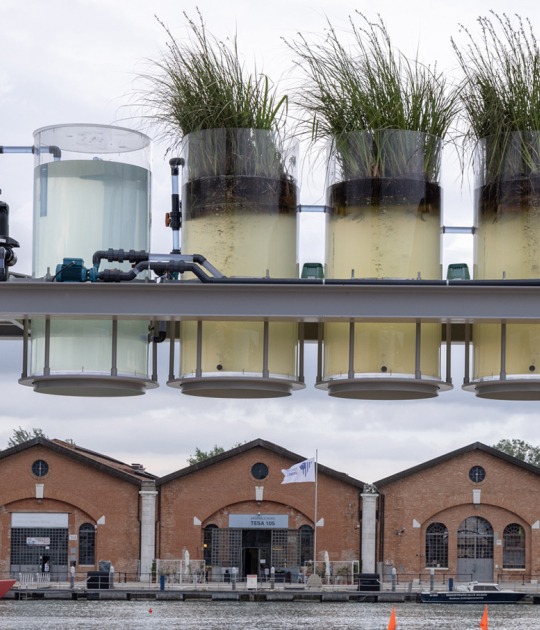The architectural proposal designed by AGi architects for this Catholic Church, that is integrated into a newly established residential area in Seville, has been led by Spanish architects Joaquin Perez-Goicoechea and Salvador Cejudo. The work was completed and blessed in September 2013, being part of the planned facilities for the area.
Description of the project by AGi architects
This building proposed by AGi architects means the completion of the Parish Center started now fifteen years ago and its empowerment as focus of community activity for a neighborhood in which more than 2,500 apartments have been recently built to house around 7,000 people, therefore increasing the existing population to reach a figure close to 20,000 inhabitants. The new building has an area of approximately 1,000 sqm including the main worship spaces and auxiliary facilities, to make final complex reach a total area of 2,000 sqm.
As per Pope Franciscus’ calls for Catholic Church major focus on the least favored, the project aims at strengthening the Parish Center as a meeting and fraternization place, in order to develop spiritual and welfare tasks, enabling the participation of different role players in the neighborhood around a community regeneration objective. The project is also extremely sensitive to the current economic circumstances, so we have resorted to materials and construction techniques chosen by economical saving and sustainability premises.
AGi architects propose a building generated from this double perspective that allows rethinking the role of religious architecture in society and what it can offer, while endowing the district with an image and sign of identity to help to combat the people’s social uprooting feeling, so common in suburban expansion areas.
Based on these ideas, AGi architect outline a spatial scheme structured through three different qualifying voids:
- A large central courtyard that belongs to the first phase of the Parish Center, already established as a meeting and community interaction place, intended now to become an urban oasis to attract the neighbors while articulating the relationships between worship spaces and the rest of facilities. Its plan surface is prolonged inwards as a stone carpet that is unfolded to enter the main space of the church and, bending towards the walls, creates a huge vessel that houses the congregation of believers, distributed around the presbytery, in an arrangement that favors the participation of all the assembly in the liturgy. Thus the binomial set by Holly and Social dimensions is strengthen to subtly help to weave such an important parish feature as it is the fabric of emotional and social relationships, even cultural ones, which ultimately constitute the identity of the parish community and its significance in the neighborhood.
- In addition, there are other two smaller scale courtyards, one of them linked to the area of the baptismal font, the other to the penitential chapel and sacristy, and they will be used to host different shelter activities (charity markets), entertainment actions (summer cinema), education (religious teaching) and spiritual rest.
Due to security reasons, the nature of shelter and interaction inherent to the project are only revealed to the outside in the main entrance that plays a relevant role as an open attraction space to welcome and invite users inside.
The shape of the roof, which unfolds freely to cover the assembly space by joining various inclined planes, allows the introduction of natural light inside, to achieve a clear qualification of the different areas needed to comply with liturgy requirements, so that spatial richness is enhanced, and the users will enjoy different experiences, from joyful expansive brightness in the main nave of the church to the mystical contemplation in the Shrine chapel, and the meditation and meeting spaces in the penitential chapel. We obtain thus the necessary coherence in a built space where the Holly and the human scales must live.
According to AGi architects’ team, "this church is very close to the community, reaching the transcendental through the existing social problems and needs. Our goal has been to open the space for community use, making it more human".
CREDITS. DATA SHEET.-
Architects.- Joaquín Pérez-Goicoechea, Salvador Cejudo.
Collaborators architects.- Daniel Muñoz, Gwenola Kergall, Bruno Gomes, Stefania Rendinelli, Javier Alonso, Daniel Bas.
Consultants.- Singe K, Ingenieros Consultores, S.L. Javier Drake Canela.


























![Friedrich Kiesler, Endless House for Mary Sisler [shattered sketch sheet], New York and Florida, 1961, 21.5 x 33.4 cm, pencil on paper, mounted on cardboard. Courtesy by the Austrian Frederick and Lillian Kiesler Private Foundation, Vienna Friedrich Kiesler, Endless House for Mary Sisler [shattered sketch sheet], New York and Florida, 1961, 21.5 x 33.4 cm, pencil on paper, mounted on cardboard. Courtesy by the Austrian Frederick and Lillian Kiesler Private Foundation, Vienna](/sites/default/files/styles/mopis_home_news_category_slider_desktop/public/2025-05/metalocus_Fundacio%CC%81n-Frederick-Kiesler_03_p.jpg?h=3b4e7bc7&itok=kogQISVW)













